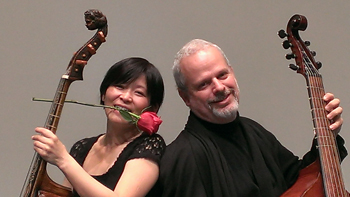by Mike Telin

Apollo’s Fire audiences will experience that brasher voice of the viola da gamba this week, as Cleveland’s baroque orchestra presents five performances of “Tangos and Fandangos with Boccherini and Friends” in area churches. The program includes René Schiffer’s “notorious” Tango Concerto for two gambas featuring Schiffer and his colleague Mime Y. Brinkmann. Elsewhere on the program the two soloists will swap out gambas for cellos to duel away in Schiffer’s Fandango.
“I chose the tango because I thought it was the perfect way to end a baroque concerto,” Schiffer said in a telephone conversation. “It has the strict rhythm of the baroque and an ostinato which relates it to the chaconne or any long piece with the same bass line played over and over again. Of course it is a total joke that two gambas are playing a tango — but at the same time, I think that when they are playing together they often sound like a bandoneón. And the noise that they can make — you never get to do that in a baroque piece.”
Schiffer says he doesn’t have a specific interest in tango except that he loves all good music. But at the time he wrote it, he was taken by the music of Astor Piazzolla, “which I think is enormously great. The piece has nothing to do with Piazzolla except maybe the ending with the two violins that resembles Argentine tango. The rest is in the European tango style, which is very regular.”
The concerto is dedicated to Schiffer’s mentor, Oberlin Conservatory faculty member Catharina Meints, “a fantastic teacher, really the best I ever had,” who will be performing two pieces on the concert herself.
When he composed his Tango Concerto, Schiffer said he was finding his own musical language by writing music in the style of many different composers. He made up whole families of pseudonyms to attribute them to. Now he says, “My style is still pretty tonal, but I have found myself worthy to use my own name.”
Schiffer went on to describe his other piece, the Fandango. “It’s for two cellos and two lutes or maybe a lute and a guitar. We’ll decide what continuo instruments to use because in the baroque period musicians were free to choose.”
The Fandango was premiered two years ago in Toledo and has been revised for the current performances. Schiffer says there’s a funny story about its debut. “I was asked to play with Kathie Stewart and Webb Wiggins at Holy Rosary Cathedral, and somebody thought it would be nice to have an all-Spanish program. We didn’t have a lot of Spanish music for flute, cello and continuo, so I started arranging some things and ended up composing the Fandango for that program. Some things worked and some didn’t, but at least we had a new piece as a result. The incentive doesn’t matter, but once the creative process begins, then things get serious!”
Published on ClevelandClassical.com November 12, 2013
Click here for a printable version of this article.



